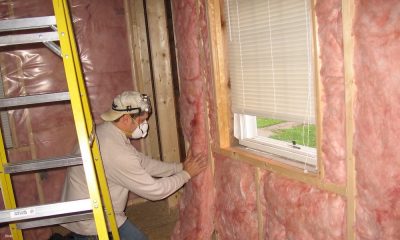Chattels Valuation Explained
In the majority of circumstances it is worthwhile having a chattel valuation completed for tax purposes. What do we mean by worthwhile?

In the majority of circumstances it is worthwhile having a chattel valuation completed for tax purposes. What do we mean by worthwhile? You will receive more than the valuation fee back in the first year in increased depreciation that you will be able to claim by having a full apportionment completed.
It has been said that Chattels Valuations for claiming depreciation are probably only worthwhile for commercial or high value domestic properties owing to the cost of getting one done.
Not so. Here are a couple of examples:
- A commercial warehouse that is literally a shell would result in one finding it hard to get sufficient increased depreciation out of that property. In this instance the Valuer should talk to the investor about the options and other benefits of the chattel valuation.
- Property was purchased for approx $500,000 as an Investment Property. A chattel valuation for this property would not be worthwhile as the land was worth $495,000 and the “outhouse” was worth the remaining $5,000.
What you need to consider is the proportion of the land from the Registered Valuation as a percentage of the Market/ Capital value. This has a large bearing on as to if a chattel valuation is worthwhile.
What you are doing by having a chattel valuation is claiming the correct depreciation rate for that particular asset (as advised by the IRD). Let’s take carpet as an example. By breaking the carpet out as a separate identifiable item, placing a specific value on the carpet, you are able to claim depreciation at 33% (diminishing value) giving an estimated life span of 5 years. (The longer the estimated life span the lower the depreciation rate). If the carpet had not been identified as a separate item depreciation could have still been claimed but possibly at 4% (estimated lifespan of 50 years) with the rest of the house.
In effect what is happening is the depreciation reflects the approximate lifespan of the asset so that you can replace it when it wears out. The asset will depreciate to the same nominal value. In the case of carpet it is whether this happens over 5 years of 50 years.
The depreciation then reflects the expected lifespan of that particular specific item.
A chattel is not necessarily just an oven but can include pretty much everything from the letter box at the front gate, the concrete path to the front door, curtains, carpets, stoves, kitchen cabinets, bathroom fixtures, floor coverings, internal non-load bearing walls, TV aerial on the roof, the garden shed, to the back fence etc. (As per the IRD Tax guide).
Other benefits for a Chattels Valuation include:
- A full breakdown of chattels, their values and the IRD depreciation rates.
- Reduced risk of penalties. This means if you are ever audited by the IRD you have substantiated values by a specialised independent third party (See our comment in the January 2005 edition of KPI in the Experts Forum)
- Easy disposal of assets. If you ever replace an item you have an accurate book value that can be written off (as opposed to your accountant taking a (conservative) guess as to its value). The new chattel is depreciated at its receipted costs.
- Minimise depreciation recovery. The report can be utilised to assist in minimising depreciation claw back when you sell the property.
- Increased cash flow by maximising the depreciation you are able to claim.

Management
Home Insulation Requirements

Home insulation keeps your property warmer in winter and cooler in summer so it just makes sense to have at least the minimum depth of insulation in the ceilings and underfloors and also in the walls too if you can do it.
European countries are getting ready for an unprecedented heat wave of 40 degrees Celsius or more, and unfortunately, people perishing the heat is unavoidable. The old and young suffer the most in extreme heat so a home that has good insulation keeps its inhabitants comfortable.
Newer countries with milder climates have seemingly avoided building homes with much consideration of insulation requirements.
Many properties have just the lining and cladding between them and a cyclone, hurricane or heatwave. However, it’s becoming apparent that in countries like Australia and New Zealand, the rising costs in healthcare have their Governments focused on improving the quality of tenanted properties.
In New Zealand, the new Healthy Homes Standards has forced the hand of landlords to comply with insulation requirements by 1 July 2019. All rental properties must have adequate ceiling and underfloor insulation.
Insulation Minimum Depth Recommendations
The recommendations for the minimum depth of insulation for the ceiling, underfloor and walls depend on the climate, and severity of weather conditions.
The UK, USA, Canada and countries like Australia and New Zealand all have depth requirements, therefore landlords need to beware that there is no ‘one size fits all’ should they decide to take on the job of fitting out a rental property for compliance.
All new homes need to be fitted with insulation in time there won’t be a residential property without it.
How Insulation Works
For the nerdy, you’ll find how insulation works fascinating. However, for the purposes of this blog post, we can summarise it as a product measured in terms of its R-Value or depth, for its thermal resistance quality.
Insulating materials differ however their role is the same and that is to prevent heat flow. Stop the heat escaping from within the home to the outdoors via the ceiling, walls and floors and also prevent hot and cold air transferring from outside into the home.
To keep homes healthy humidity levels must be kept at a normal level. This can be dealt with by opening windows and doors, to air out the home. Remember mould love a warm moist environment, but at high levels mould can be dangerous to mankind.
Insulation Types
There are many different types of insulation including radiant barriers and reflective foils which are both highly reflective so heat is not absorbed. Bulky fibre materials can be blown into the cavity, which is great for walls and ceiling, and there are the standard sheets.
Some products are made from recycled materials, like plastic, and car tyres. There are natural products like wool, cotton and straw and of course, there’s the stable material fibreglass. The list of types of insulation is long and includes many other man-made materials usually byproducts of plastics, metals and minerals.
Insulation Costs
The cost of the product will vary depending on the quality and quantity required. Natural products like wool will be more expensive than some man-made options and be aware installation costs will be driven by supply and demand.
When there is a Government initiative at play with a compliance deadline to meet, installers will raise their fees accordingly. Landlords are recommended to get their rental homes insulated before their Government makes it compulsory and costs rise with demand.
Accounting & Finance
Low Interest Rates Winners and Losers

Lower mortgage interest rates is a big deal for most homeowners and buyers.
Existing homeowners can hunt around for a better deal with the same or another lender and in the process save hundreds, if not thousands of dollars on interest payments. Even if a borrower is locked into a fixed rate deal on a fixed term, it often pays to break it and reap the rewards of paying a lot less interest.
For first time home buyers, lower interest rates can be the difference between renting and owning a home. Existing homeowners trading up or down, see lower interest rates as a great time to sell and buy too, Therefore there is always a frenzy of activity in the mortgages sector when there is movement in interest rates and there will be winners and and there will be losers.
Winners and Losers
Lower interest rates sends a signal to vendors with homes to sell, that there are more buyers in the market. This can get unsold properties sold which is a win win for vendor and buyer.
More buyers in the market, however can also push the sales price up, as vendors aim to get the best price and there can be only one buyer, the one who is willing and able to pay the most.
In this situation it’s more of a win for the vendor. The eventual purchaser is likely to have paid more than they were comfortable with and thus borrowed more to get the property. Plus there were many buyers locked out by the higher price.
First Home Buyer Tip
The tip for first home buyers is to always be ready to take action as soon as the timing is right.
For first home buyers, it’s always a good time keep a financial advisor or broker up to speed on your personal financial position. This way when the timing is right, like a downward move in interest rates, you can just ask the question:
“What can I afford to borrow, now the interest rates are lower?”
There is no such thing as one size fits all when it comes to borrowing money. Your position will determine how high risk you are to a lender.
A trusted advisor in the know, can act fast on your behalf when lending conditions favour you. Lenders who see you a good ‘investment’ will be keen to move quickly too, to secure your business and thus beat their competition, i.e. other lenders.
Recent news of an OCR rate drop by the RBNZ, spread like wildfire around the country and the early worm is sure to get the best deals.
Homeowners with advisors already up to speed on their current position, will be busy acting on their behalf, to find the best deal saving their clients hundreds if not thousands in interest repayments over the term of their loan.
Property price increases have cooled in Auckland, increasing by just 1.7 percent compared to the previous year. Listings too have been lower, however that’s all about to change. More buyers, trigger more listings and with more buying power, higher property prices.
Timing is everything, so whatever your circumstance, talk to your mortgage advisor and act on the deal that’s right for you.
Build
How to Choose and Purchase a Suitable Property to Subdivide

With the demand for housing in Auckland at peak levels and even smaller-scale properties showing substantial profit margins when sold, subdividing a lot into two or more sections has huge earning potential. Those with the means and capabilities to purchase land for the purpose of subdividing are almost certain to see a large return-on-investment, that is of course, as long as it is done correctly.
Choosing a property to subdivide while exploring real estate options requires the assessment of a multitude of factors. Whether or not a property is capable of being subdivided will depend on its size, its location and the physical layout of the property. It’s not always as easy as choosing the biggest section out there and splitting it down the centre.
Considerations are not just restricted to feasibility either. Property investors taking this route should always keep profitability at front of mind. The effort put into the property needs to be reflected in resale value. At times, just because you can subdivide, doesn’t mean you should.
Factors to Consider When Looking to Purchase a Property with the Potential to be Subdivided
The Size of the Property
When it comes to subdividing, size definitely does matter. Generally, the larger the section the better the earning potential will be. On the other hand, it’s important to keep in mind that section size will also affect overheads. Larger sections typically incur higher costs while performing due diligence.
Land Layout
Level land is important, it will be easier to build on and will be more appealing when it’s back on the market. If a potential section is uneven or has landscape issues, it can make property development more difficult. Choosing a property that is already level will allow a smoother process.
Steps should also be taken to assess how easy it will be for multiple households to live on the lot. Consider issues like driveway creation, road and utility access, and street frontage. These factors will affect council consent and appeal once you’ve placed your subdivided property on the market.
The Zoning Rules of the Area
How the area the property is located in is zoned will restrict the type of housing you are able to create and can even cancel out any plans to subdivide. Before purchasing a property, it is crucial to research council zoning restrictions and consider how they will dictate your subdivision plans. Choosing to work with a subdivision consultant will help you navigate this process if you aren’t sure about taking it on yourself.
Subdividing is one of the most profitable actions a property owner can take. The ability to sell two lots from the purchase of one can exponentially boost your earnings from your investment. Council restrictions and market appeal will have an impact on how your subdivision journey will play out. However, with these considerations taken into account while you search, it is entirely possible to choose a property that will offer worthwhile returns.
-

 Management5 years ago
Management5 years agoHome Insulation Requirements
-

 Investment5 years ago
Investment5 years agoAnother date NZ property investors are dreading
-

 Accounting & Finance5 years ago
Accounting & Finance5 years agoLow Interest Rates Winners and Losers
-

 Build5 years ago
Build5 years agoHow to Choose and Purchase a Suitable Property to Subdivide
-

 Management6 years ago
Management6 years agoAttracting More Business Travellers To Your Auckland Airbnb Property
-

 Investment6 years ago
Investment6 years agoWould You Be a Landlord in 2018?
-

 Tenants6 years ago
Tenants6 years agoCoworking Countdown – 4 Things to Prepare Before You Move In
-

 Renovations6 years ago
Renovations6 years agoFive easy steps to boost the appeal of your home